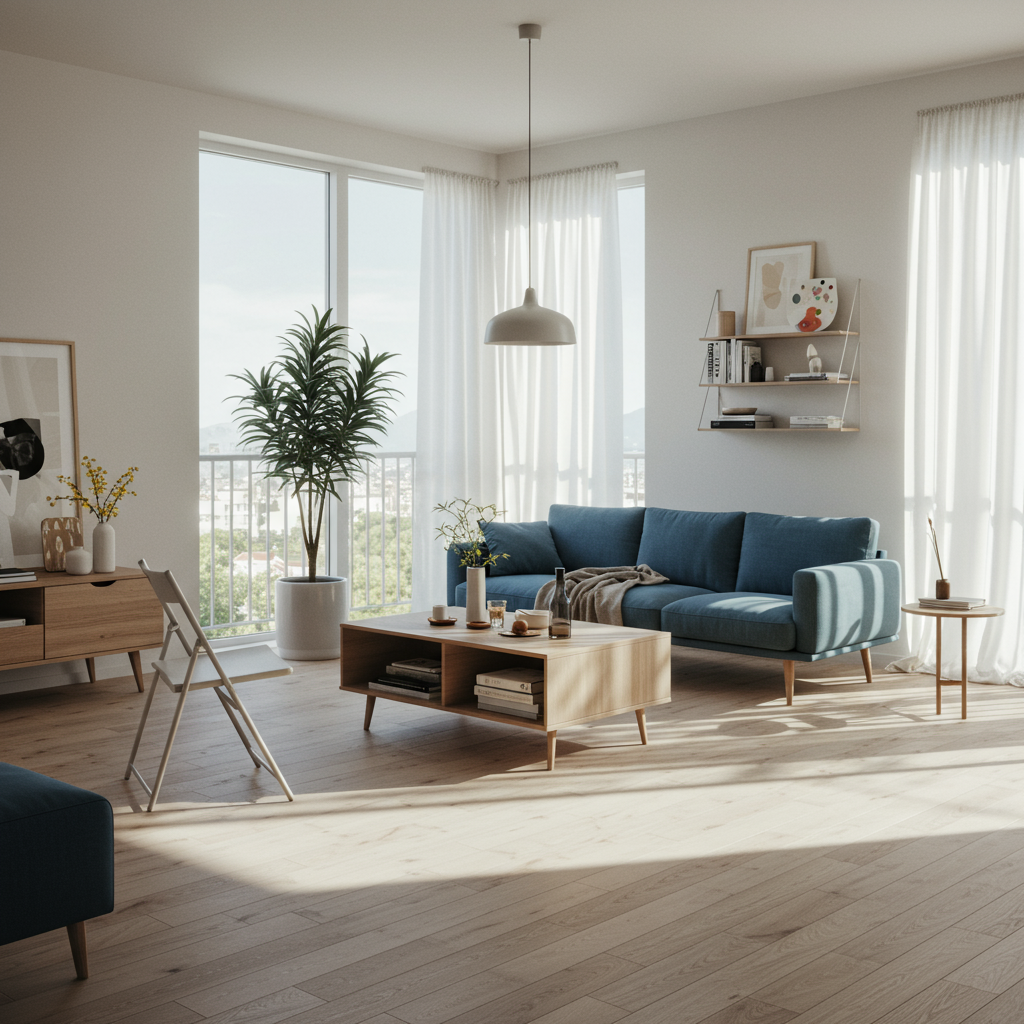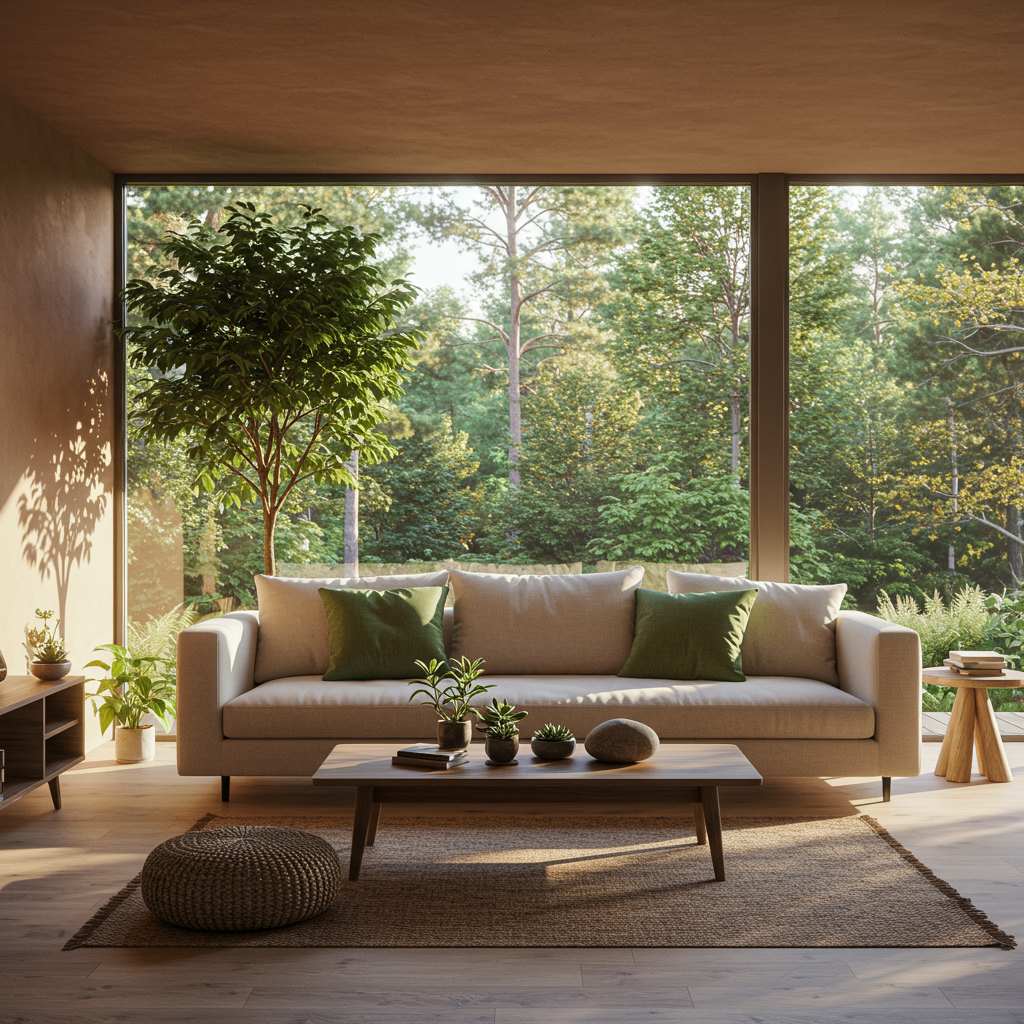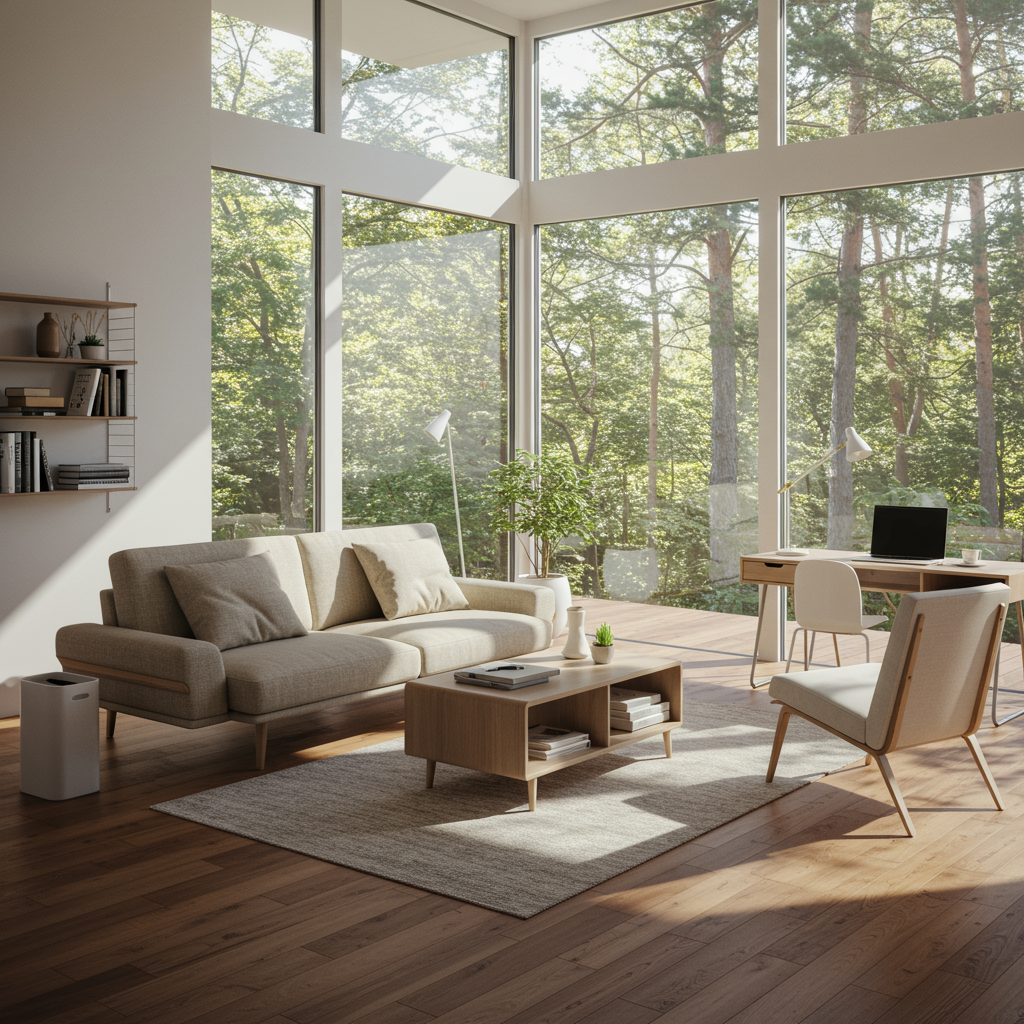Minimalism has taken the home design world by storm, and for good reason. In a fast-paced life filled with clutter and distractions, creating a serene space can offer a much-needed sanctuary. Minimalist living room designs not only promote tranquility but also maximize space, making them ideal for both small apartments and larger homes. With the right design elements, you can make even the coziest of spaces feel expansive and inviting. In this article, we will explore eight minimalist living room designs that effectively maximize space while keeping your environment stylish and functional.
“`html
| Feature | Details |
|---|---|
| Color Palette | Neutral tones to create a calming atmosphere |
| Furniture Selection | Multi-functional furniture to save space |
| Lighting | Natural light sources and minimalistic fixtures |
| Decor | Limited decorative items to avoid clutter |
| Layout | Open floor plans to enhance flow and space |
| Storage Solutions | Built-in shelves and hidden storage options |
| Textiles | Simple fabrics that add warmth without overwhelming |
“`
1. Open Concept Layouts
One of the most effective ways to create a spacious feel in your living room is through an open concept layout. This design philosophy involves removing barriers between rooms, allowing natural light and sightlines to flow freely. By merging your living area with adjacent spaces, like the kitchen or dining room, you create a seamless environment that feels larger and less confined.
To achieve this look, consider utilizing furniture that can serve multiple purposes. For example, a sleek sofa can be paired with a minimal dining table that also functions as a workspace. This not only saves space but also maintains the clean aesthetic associated with minimalism.
2. Neutral Color Palettes

Colors play a crucial role in how we perceive space. A neutral color palette can make your living room feel open and airy. Shades of white, beige, and light gray reflect light, which can help to visually enlarge the room. When choosing furniture and decor, opt for pieces in similar tones to enhance the cohesive look.
Incorporating different textures through textiles—such as a soft wool throw or a jute rug—can also add depth to a neutral space while keeping the overall aesthetic uncluttered. Remember, the key is to keep it simple, with just a few well-chosen accent pieces that will not overwhelm the senses.
3. Multi-Functional Furniture

In a minimalist living room, every piece of furniture should serve a purpose. Multi-functional furniture is an excellent solution for maximizing space. Look for items like ottomans that can double as storage units or coffee tables that can expand when needed. These versatile pieces not only save room but also reduce the need for excess furniture.
For example, a wall-mounted desk can provide a workspace without taking up valuable floor space, leaving the room feeling open and inviting. Consider investing in furniture that can adapt to your needs, allowing you to tailor your space for various activities without sacrificing style or comfort.
4. Vertical Storage Solutions
When floor space is limited, it’s time to think vertical. Utilizing wall space for storage can significantly enhance the functionality of your minimalist living room. Floating shelves, tall bookcases, and wall-mounted cabinets can keep your belongings organized without taking up precious floor space.
By arranging items vertically, you draw the eye upward, creating the illusion of height and space. Keep in mind to maintain a minimalistic approach by selecting a few decorative items or books to display. This will prevent the shelves from looking cluttered while still showcasing your personal style.
5. Strategic Lighting
Lighting can dramatically affect the ambiance and perceived size of your living room. By layering different types of light—ambient, task, and accent—you can create a warm and inviting space that feels larger than it is. Use floor lamps, table lamps, and wall sconces to add light without overwhelming the room with fixtures.
Natural light should also be maximized. Avoid heavy drapes and opt for sheer curtains that allow sunlight to filter in. Mirrors can also be a clever addition; placing a large mirror opposite a window can reflect light and create an illusion of more space.
6. Minimalist Accessories
In a minimalist design, less truly is more. When it comes to accessories, choose a few standout pieces instead of crowding your space with numerous items. A single piece of artwork or a striking sculpture can serve as a focal point and enhance the overall aesthetic without overwhelming the room.
When accessorizing, consider the scale and proportion of your items. Large, bold items can create a sense of drama, while small items can get lost in the space and contribute to clutter. Be intentional about each piece you choose to ensure that it complements your minimalist vision.
7. Streamlined Furniture Shapes
Minimalist furniture often features clean lines and simple shapes that contribute to a more open feel. Sofas and chairs with sleek designs can help eliminate visual clutter and make the room feel more spacious. Opt for furniture with exposed legs instead of solid bases, as this further opens up the floor space and creates a lighter look.
Additionally, consider modular furniture that can be rearranged or adapted to fit your changing needs. This flexibility not only maximizes space but also allows you to evolve your living area over time.
8. Incorporating Nature

Bringing elements of nature into your living room can enhance the minimalist vibe while promoting a sense of peace. Incorporate plants or natural materials like wood and stone to create a calming atmosphere. A few well-placed plants can add a splash of color and life without cluttering the space.
Choose low-maintenance plants that fit your lifestyle, such as succulents or snake plants, to ensure that they remain a beautiful, effortless addition to your decor.
9. Thoughtful Layout Planning

When designing a minimalist living room, careful planning of your layout can make a significant difference in how spacious and functional the area feels. Begin by considering the flow of movement through the room. Arrange furniture in a way that allows for easy navigation and makes the most of natural pathways. This can be particularly important in smaller spaces, where optimizing every square foot is crucial.
Consider creating distinct zones within the living room, such as a reading nook with a comfortable chair and a small side table, or a conversation area with a few strategically placed chairs around a coffee table. By delineating these spaces without using physical barriers, you maintain an open feel while providing functionality. Utilizing rugs to define areas can also enhance this effect, giving each zone its own character while still adhering to a minimalist design.
10. Emphasizing Functionality Over Trend

Minimalism is about reducing excess and focusing on what truly matters in your space. While trends can be tempting, prioritizing function over fleeting styles is essential in a minimalist living room. Choose furniture and decor that are timeless in design, ensuring they serve a practical purpose and align with your lifestyle.
For instance, invest in a quality sofa that offers comfort and durability rather than one that is simply fashionable. This approach not only enhances the longevity of your space but also contributes to a more cohesive overall design. Remember, a well-planned minimalist living room should not only look good but also be a comfortable and functional living space that meets your everyday needs.
11. Incorporating Technology Wisely
In today’s digital age, technology is an integral part of our lives, but it can also contribute to clutter if not managed properly. In a minimalist living room, it’s important to integrate technology in a way that complements your design rather than detracts from it. Consider using built-in solutions for your television and sound systems, which can help maintain clean lines and a cohesive look.
Wireless technology can also be your friend in a minimalist space. Opt for wireless speakers and streaming devices that eliminate the need for cables and external clutter. Moreover, consider a stylish media console that provides storage for gadgets and accessories, keeping your living area organized and visually appealing.
12. Using Art and Decor Sparingly
Art and decor can bring personality to your minimalist living room, but it’s essential to use them sparingly. A single large piece of art can make a bold statement without overwhelming the space, while a few well-placed decor items can enhance the overall aesthetic. Look for artwork or decor that resonates with you personally, as this will help to create a more inviting atmosphere.
When selecting decor, consider the size, color, and texture to ensure it aligns with your minimalist vision. A large canvas painting can serve as a focal point, while smaller items can be grouped together on a shelf or table to create visual interest without cluttering the space. Aim for a balance that reflects your taste without compromising the minimalist philosophy.
13. Choosing the Right Flooring
The flooring you choose can significantly impact the feel of your living room. Minimalist designs often benefit from hardwood or light-colored flooring, which can help to create an airy atmosphere. If you prefer a softer surface, opt for low-pile rugs that provide comfort without adding bulk. Avoid overly ornate patterns and colors that could distract from the clean lines and simplicity of your space.
Additionally, consider using area rugs strategically to define spaces within your living room. A well-placed rug can tie a room together and delineate different zones, enhancing the overall functionality while contributing to the minimalist aesthetic.
14. Keeping It Personal
While minimalism emphasizes simplicity and functionality, it’s important to ensure your living room remains personal. Incorporate elements that reflect your unique style and interests, whether it’s through a carefully curated selection of books, a few cherished photographs, or a small collection of meaningful mementos.
To keep the space feeling open and organized, limit the number of personal items on display and rotate them periodically. This approach allows you to keep the decor fresh and engaging without overwhelming the minimalist concept. Remember that each piece should bring you joy and contribute to the tranquil atmosphere you seek to create.
15. Continuous Re-evaluation
Minimalism is not a one-time project but an ongoing process of evaluation and adjustment. As your lifestyle and needs change, so too should your living space. Regularly assess your furniture, decor, and overall layout to determine what still serves a purpose and what may need to be adjusted or removed.
Embrace the freedom that comes with minimalism—knowing that you can change your space as your life evolves. This not only keeps your living room feeling fresh and relevant but also reinforces the minimalist principle of living with intention and clarity.
16. Embracing Open Shelving
Open shelving can be a beautiful addition to a minimalist living room, offering both functionality and aesthetic appeal. Unlike traditional closed cabinets, open shelves allow you to display your favorite books, decorative items, and plants while keeping everything accessible. This design choice can create an airy feel, as it opens up the visual space and draws the eye upward.
To make the most of open shelving, select a few key pieces to display, rather than filling every inch with items. This approach not only prevents clutter but also allows for a curated look that reflects your personality. Consider using uniform baskets or boxes to organize smaller items, which can also add texture and color without overwhelming the space.
17. Creating a Cozy Atmosphere with Textiles
Textiles play a vital role in adding warmth and comfort to a minimalist living room. While the overall aesthetic should remain simple, incorporating soft fabrics can make the space feel inviting. Choose a few well-placed cushions, a soft throw blanket, or a cozy area rug to enhance the comfort level without adding clutter.
When selecting textiles, focus on high-quality materials in neutral color palettes to maintain the minimalist vibe. Natural fibers such as cotton, linen, and wool can add tactile elements that invite relaxation. Layering different textures—like a chunky knit throw on a smooth sofa—can create visual interest while still adhering to the minimalist philosophy.
18. Utilizing Color Accents Wisely
While a neutral palette is a hallmark of minimalism, incorporating color accents can bring life to your living room. Use vibrant hues sparingly to create focal points that draw attention without overwhelming the space. A bright cushion, a bold piece of artwork, or a colorful vase can serve as an eye-catching element that enhances the overall design.
When adding color, consider the emotional impact of different shades. Blues and greens can promote tranquility, while warm tones like yellows and oranges can evoke energy and happiness. The key is to choose colors that resonate with you personally, enabling your living room to reflect your individual style while remaining a peaceful retreat.
19. Balancing Symmetry and Asymmetry
In minimalist design, achieving balance is crucial for creating a visually pleasing space. While symmetry can evoke a sense of order and calm, asymmetrical arrangements can bring dynamism and interest. Striking the right balance between these two approaches can enhance the overall aesthetic of your living room.
For instance, you might opt for a symmetrical layout with your sofa flanked by matching side tables, while adding an asymmetrical element such as a large piece of artwork on one side. This combination creates a harmonious look that feels balanced yet lively. Pay attention to the proportions of your furniture and decor; larger items can anchor a space, while smaller pieces can be scattered for a more casual feel.
20. The Art of Decluttering
Decluttering is an essential practice in minimalist living. Regularly assess your belongings to determine what you truly need and what can be removed from the space. This process not only helps maintain a serene environment but also allows you to make room for new items that genuinely enhance your living area.
Start by tackling one area at a time, such as your coffee table or shelves. Evaluate each item based on its utility and emotional value; if it doesn’t serve a purpose or bring you joy, consider letting it go. This ongoing practice of decluttering is vital for sustaining the minimalist lifestyle and ensuring that your living room remains a peaceful sanctuary.
21. Incorporating Smart Home Solutions
Smart home technology can complement a minimalist design by enhancing functionality without adding visual clutter. Devices like smart thermostats, lighting systems, and speakers can be integrated into your living space seamlessly. Opt for smart devices that blend in with your decor and can be controlled through an app or voice commands, minimizing the need for visible remotes and cables.
Consider using smart lighting solutions that allow you to adjust brightness and color temperature to create the perfect ambiance for any occasion. This not only enhances the functionality of your living room but also aligns with the minimalist principle of simplifying your environment.
22. Mindful Consumption Practices
Minimalism extends beyond just design; it encompasses a lifestyle centered on mindful consumption. As you curate your living space, consider the impact of each purchase on your overall aesthetic and functionality. Opt for quality over quantity by investing in pieces that are timeless, versatile, and enduring, rather than succumbing to trends that may lead to clutter in the future.
This approach not only enhances the longevity of your living room but also promotes a more sustainable lifestyle. By being intentional about what you bring into your home, you create a space that reflects your values while maintaining the minimalist ideals of simplicity and clarity.
23. The Importance of Maintenance
Lastly, maintaining a minimalist living room requires regular upkeep to ensure that it remains clutter-free and functional. Set aside time each week to tidy up and reassess your belongings, ensuring that everything has a designated place. This practice helps to keep your living space organized, minimizing the chances of clutter accumulating over time.
Additionally, consider establishing a routine for cleaning and maintaining your furniture and decor. Simple actions, like dusting surfaces and washing textiles, can go a long way in preserving the beauty and functionality of your minimalist space. By committing to ongoing maintenance, you can fully enjoy the benefits of a serene and stylish living room.
